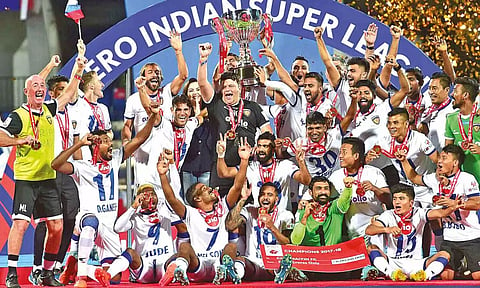

CHENNAI: In a country, where cricket has long reigned as the undisputed king of sports, a quiet revolution was brewing on the football pitches that had been overshadowed for generations. It was the dawn of a new era for Indian football, and it came in the form of the Indian Super League (ISL)
The year was 2014, and the ISL burst onto the scene, promising to transform the landscape of football in a nation where cricket had dominated the sporting psyche.
With star-studded teams, international coaches, and marquee players, the league was an instant hit, capturing the imagination of millions of Indians.
In the early days of the ISL, there was skepticism. Critics questioned whether a franchise-based football league could truly ignite the passion for the sport the country. However, the league quickly silenced its doubters as it gained traction and began to reshape the footballing narrative in India.
One of the most significant contributions of the ISL to Indian football was the influx of top-notch talent from around the world. World-class players, including former World Cup winner Marco Materazzi, Del Piero, Robert Pires, and David Trezeguet, graced
the Indian pitches, bringing with them a wealth of experience and a touch of magic that was previously unseen in Indian football. These international icons influenced even a regular sports fan to come and watch them at the stadiums.
The impact of foreign players was not limited to the field. Their presence raised the overall quality of the game in the ISL and accelerated the development of local talent.
Indian players had the unique opportunity to train and compete alongside these legends, learning invaluable skills and techniques that would help them in their international careers.
As the years rolled on, the ISL continued to evolve with the introduction of youth development initiatives. Clubs began investing in grassroots programs, nurturing young talent from the hinterlands of the country.
The emergence of players like Udanta Singh, Jerry Lalrinzuala, and Anirudh Thapa, products of these youth systems, demonstrated the league’s commitment to building a strong foundation for Indian football.
The ISL also played a pivotal role in improving the infrastructure for football in India. The league prompted clubs to upgrade their respective stadiums, training facilities, and medical support systems to meet international standards. This not only enhanced the overall football experience but also created a safe and conducive environment for players to thrive.
One cannot ignore the power of fan engagement in the growth of football in India. The ISL introduced a vibrant and passionate fan culture that had been silent in Indian football for decades.
The introduction of fan clubs, passionate chants, banners and tifo added a new dimension to the sport, transforming it from a mere spectacle into a deeply emotional experience.
The Kolkata Derby, a fixture between Mohun Bagan Super Giant and East Bengal, is a rivalry that is more than 100 years old now, and with these two clubs entering the fray in ISL season 2020–21, it brought with it the rich history of Indian football and passionate fans across different age groups.
Some of the greatest names from the game in the country have been a part of either of these clubs, and as the saying goes, ‘scoring in the Kolkata Derby can make you a hero from a zero’.
With the ISL providing a platform for Indian football to shine, the national team also reaped the rewards.
India’s FIFA rankings began to climb steadily, and the country started to make a mark on the Asian footballing scene.
The highlight of this resurgence came in 2019, when the Indian national team secured qualification for the AFC Asian Cup after a gap of eight years. This achievement was a testament to the progress made in Indian football, and the ISL had played a pivotal role in this journey.
The league’s impact extended beyond the matchdays. Football academies mushroomed across the country, offering young aspirants the opportunity to pursue their dreams.
The success stories of players like Sunil Chhetri, Gurpreet Singh Sandhu, and Jeje Lalpekhlua, who emerged from humble beginnings to become national heroes, served as beacons of hope for countless youngsters.
In addition to player development, the ISL also contributed to the overall growth of the football ecosystem in India.
Today, the ISL continues to push boundaries, nurture talent, and foster a footballing culture that once seemed unattainable in India.
The league’s efforts were rewarded when the Indian national team once again started to dominate competitions such as the SAFF championship and the 2023 Intercontinental Cup, competing with Asian giants on equal footing.
With the World Cup qualifiers approaching in November, the journey from football obscurity to qualifiers is a testament to the ISL’s transformative power.
The league had not only elevated the quality of Indian football but also ignited a passion for the sport that will sure transcend generations. —JSG